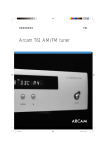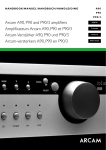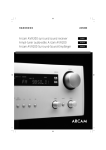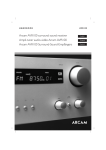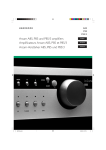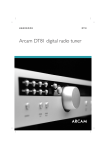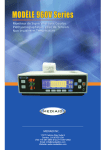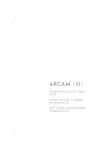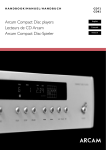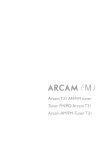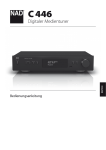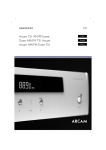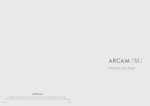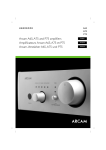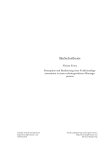Download Arcam T61 Operating instructions
Transcript
HANDBOOK Arcam T61 AM/FM tuner Tuner FM/PO Arcam T61 Arcam AM/FM-Tuner T61 T61 English Français Deutsch Safety guidelines CAUTION ATTENTION RISK OF ELECTRIC SHOCK DO NOT OPEN RISQUE DE CHOC ELECTRIQUE NE PAS OUVRIR CAUTION: To reduce the risk of electric shock, do not remove cover (or back). No user serviceable parts inside. Refer servicing to qualified service personnel. WARNING: To reduce the risk of fire or electric shock, do not expose this apparatus to rain or moisture. The lightning flash with an arrowhead symbol within an equilateral triangle, is intended to alert the user to the presence of uninsulated ‘dangerous voltage’ within the product’s enclosure that may be of sufficient magnitude to constitute a risk of electric shock to persons. The exclamation point within an equilateral triangle is intended to alert the user to the presence of important operating and maintenance (servicing) instructions in the literature accompanying the product. Unplug the unit from the mains supply before cleaning. The case should normally only require a wipe with a soft, damp, lint-free cloth. Do not use paint thinners or other chemical solvents for cleaning. We do not advise the use of furniture cleaning sprays or polishes as they can cause indelible white marks if the unit is subsequently wiped with a damp cloth. 9. Power sources Only connect the appliance to a power supply of the type described in the operating instructions or as marked on the appliance. 10. Power-cord protection CAUTION: In Canada and the USA, to prevent electric shock, match the wide blade of the plug to the wide slot in the socket and insert the plug fully into the socket. Power supply cords should be routed so that they are not likely to be walked on or pinched by items placed upon or against them, paying particular attention to cords and plugs, and the point where they exit from the appliance. Important safety instructions 11. Grounding This product is designed and manufactured to meet strict quality and safety standards. However, you should be aware of the following installation and operation precautions: Ensure that the grounding means of the appliance is not defeated. 12. Power lines 1. Take heed of warnings and instructions Locate any outdoor antenna/aerial away from power lines. You should read all the safety and operating instructions before operating this appliance. Retain this handbook for future reference and adhere to all warnings in the handbook or on the appliance. 13. Non-use periods 2. Water and moisture The presence of electricity near water can be dangerous. Do not use the appliance near water – for example next to a bathtub, washbowl, kitchen sink, in a wet basement or near a swimming pool, etc. 3. Object or liquid entry Take care that objects do not fall and liquids are not spilled into the enclosure through any openings. Liquid filled objects such as vases should not be placed on the equipment. 4. Ventilation Do not place the equipment on a bed, sofa, rug or similar soft surface, or in an enclosed bookcase or cabinet, since ventilation may be impeded. We recommend a minimum distance of 50mm (2 inches) around the sides and top of the appliance to provide adequate ventilation. 5. Heat Locate the appliance away from naked flames or heat producing equipment such as radiators, stoves or other appliances (including other amplifiers) that produce heat. 6. Climate If the unit has a standby function, a small amount of current will continue to flow into the equipment in this mode. Unplug the power cord of the appliance from the outlet if left unused for a long period of time. 14. Abnormal smell If an abnormal smell or smoke is detected from the appliance, turn the power off immediately and unplug the unit from the wall outlet. Contact your dealer immediately. 15. Servicing You should not attempt to service the appliance beyond that described in this handbook. All other servicing should be referred to qualified service personnel. 16. Damage requiring service The appliance should be serviced by qualified service personnel when: A. the power-supply cord or the plug has been damaged, or B. objects have fallen, or liquid has spilled into the appliance, or C. the appliance has been exposed to rain, or D. the appliance does not appear to operate normally or exhibits a marked change in performance, or E. the appliance has been dropped or the enclosure damaged. The appliance has been designed for use in moderate climates. Safety compliance 7. Racks and stands This product has been designed to meet the IEC 60065 international electrical safety standard. Only use a rack or stand that is recommended for use with audio equipment. If the equipment is on a portable rack it should be moved with great care, to avoid overturning the combination. T61 2 8. Cleaning This handbook has been designed to give you all the information you need to install, connect, set up and use the Arcam T61 tuner. The CR-389 remote control handset supplied with this equipment is also described. Safety Safety guidelines are set out on the inside front cover of this handbook. Many of these items are common sense precautions, but for your own safety, and to ensure that you do not damage the unit, we strongly recommend that you read them. Radio interference All Arcam products have been designed to very high standards of electromagnetic compatibility. However, both CD players and DVD players generate RF (radio frequency) energy. In some cases this can cause interference with FM and AM radio reception. If this is the case, switch the player off or keep the player and its connecting cables as far from the tuner and its aerials as possible. Connecting the player and the tuner/amplifier to different mains sockets can also help to reduce interference. EU countries This product has been designed to comply with directive 89/336/EEC. USA This product complies with FCC requirements. If the equipment causes interference to radio/television reception, which can be determined by switching the equipment off and on, the following measures should be taken: Re-orientate the receiving antenna or route the antenna cable of the receiver as far as possible from this appliance and its cabling. Relocate the receiver with respect to this appliance. Connect the receiver and this appliance to different mains power outlets. If the problem persists contact your Arcam dealer or Arcam Customer Support on +44 (0)1223 203203. Information on radio transmissions A free booklet (number 004-000-00345-4) is available from the U.S. Government called ‘How to Identify and Resolve Radio-TV Interference Problems’ by writing to: The U.S. Government Printing Office Washington, D.C. 20402. The British Broadcasting Corporation publishes a booklet entitled ‘Radio Transmitting Stations’ which contains details of all BBC transmitters in the UK together with other useful hints and tips. This booklet can be obtained on request by sending a large stamped addressed envelope to:- English Using this handbook Contents Safety guidelines Important safety instructions Safety compliance 2 2 2 Using this handbook Safety Information on radio transmissions 3 3 3 Installation Positioning the unit Setting up the tuner Connecting to other equipment Connecting to a power supply Custom installation features IR codes 4 4 4 5 5 5 5 Using your tuner Front panel controls Operation Storing a preset Deleting an unused preset RDS: Radio Data System Entering station names manually 6 6 6 7 7 7 7 Using the CR-389 remote control 8 Technical specifications Table of IR commands 9 10 Guarantee 11 On line registration 11 The UK Radio Authority publishes ‘The Radio Authority Pocket Book’ which contains details of all independent radio stations. This booklet can be obtained on request by sending a large stamped addressed envelope to:Holbrook House 14 Great Queen Street Holborn LONDON WC2B 5DG Telephone: 0207 430 2724 Fax: 0207 405 7062 E-mail: [email protected] Internet: www.radioauthority.org.uk Engineers Dept. BBC Radio 201 Wood Lane LONDON W12 7TS Telephone: 08700 100 123 Internet: www.bbc.co.uk/enginfo/fm_recep T61 3 Installation AUDIO OUTPUTS IR IN POWER INLET 120V 12V TRIGGER IN AM R 230V 2 3 4 5 T61 rear panel 2 6 7 89 1 Socket for IEC power inlet line 2 Voltage selector switch 3 Remote control input 4 Power On/Standby trigger in 5 AM step switch Positioning the unit 5 The AM tuning ‘step size’ needs to be set according to your location. This is done using the switch on the rear panel: set it to 10kHz if you are in North America, or 9kHz anywhere else. This switch also ensures correct reproduction of FM broadcasts for your location. AM aerial An AM aerial is required to receive AM/Medium Wave radio signals. An external AM loop aerial is supplied as an accessory. This should be attached to the AM Antenna inputs with one end connected to AM and the other to Ground . It does not matter which way round this aerial is fitted. Rotate the aerial to discover which position gives the best reception. 9 7 8 9 pairs FM coaxial plug Ground socket (for AM loop aerial) AM socket (for AM loop aerial) An FM aerial is required to receive VHF radio signals. An external FM ribbon aerial is supplied as an accessory. Setting up the tuner AM step switch 6 Audio output phono sockets, two FM aerial Always place the tuner on a level, firm surface. 8 In areas of weak reception or when the receiver is used inside a steel framed building (such as an apartment building) you can use a wire between 3 and 5 metres long to strengthen reception. Mount this high up outside the building, if possible, and connect one end of this wire to the AM antenna input as well as the loop aerial supplied. DO NOT DISCONNECT THE LOOP AERIAL. 9 T61 4 GND L AM STEP 1 1 AERIALS FM 75 For optimal FM radio reception a roof or loft mounted aerial is advised. For your own safety it is recommended that a roof top aerial is fitted by an experienced contractor. Your Arcam dealer should be able to put you in contact with an aerial installer. A contractor will be able to tune your aerial to the nearest FM transmitter. In an apartment building an aerial system may already be installed. If this is the case you should have sockets in your home marked FM or VHF (do not use those marked TV). The ‘T’ shaped wire aerial (dipole design) supplied should give reasonably good reception. Mount this aerial as high up as possible on a wall with the elements positioned horizontally. Try each usable wall of the room to see which gives best reception. Use tacks or adhesive tape to secure the aerial in a T-shape. The tacks should not come into contact with the internal wire of the aerial. Whether you decide to get an aerial professionally installed or opt to use the supplied aerial it should be connected to the FM Antenna input on the rear of the unit. 7 For use in North America, use an F-type antenna connector; for Europe and other areas, use a female Belling Lee-type coaxial connector. Interconnect cables Interconnecting cables are not supplied with this tuner. We recommend high quality cables as inferior quality cables will degrade the sound quality of your system. Please contact your Arcam dealer for details of suitable cables. Connecting your tuner to your amplifier Audio outputs 6 Two pairs of identical outputs are provided. Connect one set to your amplifier’s tuner input or any other line-level input using suitable high quality interconnect cables. Ensure that the left and right audio outputs from the tuner are connected to the same left and right inputs on your amplifier. The second set of audio outputs can be used to connect to a second amplifier set up for ‘multiroom’ use, or routed to a tape recorder for ‘off air’ recording. Custom installation features The T61 has a number of useful features that make it ideal for a custom installation, where the tuner is fully integrated with a specialist control system or operated by a programmable remote control. Remote control input 3 A rear panel input that receives modulated carrier-based infrared (IR) commands in RC5 format. The input is suitable for connection to a simple IR eye or to an external controller. Use of this socket disables the front panel IR eye. Trigger input 4 The trigger socket allows the tuner to be remotely switched in and out of standby. The primary front panel POWER switch must be in, ‘on’, for this mode. Apply a +12V DC voltage for ‘on’, the power indicator glows green; 0V for ‘standby’, the power indicator glows red. Connecting to a power supply Note that use of this socket requires a 12V signal before the tuner can be switched fully on. Wrong plug? Infrared (IR) remote commands Check that the plug supplied with the unit fits your supply and that your mains supply voltage agrees with the voltage setting switch (120V or 230V) indicated on the rear panel of the unit The T61 responds to a set of Philips RC-5 codes in addition to those available on the supplied handset, which is kept simple for ease of use. 2. Advanced programmable control devices, such as the Philips ‘Pronto’ and other system controllers, can be set up to use the additional codes. Refer to the instructions for your programmable device for details. If your mains supply voltage is different, switch the voltage selector across using a small screwdriver. Mains lead The appliance is normally supplied with a moulded mains plug already fitted to the lead. If for any reason the plug needs to be removed, it must be disposed of immediately and securely, as it is a potential shock hazard when inserted into the mains socket. Should you require a new mains lead, contact your Arcam dealer. A table of IR commands is provided on page 10 of this Handbook. Plugging in Push the plug (IEC line socket) of the power cable supplied with the unit into the POWER INLET socket in the back of the unit. Make sure it is pushed in firmly. 1 Put the plug on the other end of the cable into your power supply socket and switch the socket on. T61 5 English Connecting to other equipment Using your tuner T61 AM/FM TUNER PRESET 12 BAND 1 RDS MONO STORE 2 3 4 5 67 1 Directly select up to 32 preset stations (16 AM, 16 FM). Press briefly for stations 1–8, press and hold for more than one second for stations 9–16. BAND 2 Selects FM or AM frequency band. The appropriate letters appear on the display. MHz 8 POWER POWER 9 bk blbm bl Switches the mains power to the unit on or off. Power indicator bm This glows green to show that the unit is ready for use. The indicator glows red in standby mode when the tuner is switched off via the remote control, or configured in a custom installation. Operation Switches between RDS modes on FM if RDS is available. See the section ‘RDS: Radio Data System’. The T61 radio tuner can be controlled from the front panel buttons or from the remote control handset (see ‘Using the remote control’). MONO Tuning to a station RDS 3 4 Selects mono or stereo output. Stereo is only available on FM radio stations. If a weak station is received in stereo the background hiss can be reduced (and in most cases eliminated) by selecting ‘MONO’. Pressing the TUNING button toggles between the two tuning modes of the unit – ‘Preset’ or ‘Tune’. The selected mode is briefly shown in the display. In mono mode, FM muting is suppressed when tuning between stations and the ‘FM MUTE’ indicator is switched off. In Preset mode, press the or buttons on the front panel (or < or > on the remote control handset) to cycle up and down the preset stations. STORE 5 Preset mode 5 6 The STORE button allows you to assign radio stations to preset numbers. See the instruction ‘Storing a preset’ See ‘Storing a preset’ and ‘Deleting unused presets’, below. Preset indicator Automatic tuning: Press the or buttons on the front panel (or < or > on the remote control handset) for longer than one second to engage automatic tuning. The tuner searches for a radio station signal of sufficient strength and stops. To skip to the next station, press one of the buttons again. Automatic tuning is available for both the FM and AM bands. 6 Indicates the number of the preset currently selected. Signal strength 7 A seven-step indicator shows the strength of a tuned station. Good FM reception and locking onto RDS data generally requires five or more bars. Tuning 8 Switches between Tune and Preset mode for the down/up buttons. Preset mode is indicated by PRESET on the display. Tune down/up 9 Used to either scroll through presets, or to tune up and down the broadcast band, depending on the current mode. See ‘Tuning to a station’ for more details. Frequency/ RDS display T61 6 FM 103.50 TUNING Front panel Controls Preset Memory buttons FM MUTE STEREO SIGNAL TUNED bk Indicates the frequency of the selected station in MHz (FM) or kHz (AM); it also displays RDS information when present. Tune mode 5 6 Manual tuning: Tap the or buttons for manual tuning. This can be used for tuning to a specific frequency. It is also useful if you are trying to select a station that is too weak for the auto search mode. 5 6 Regardless of the mode used to tune your T61, when it is accurately tuned to a station ‘TUNED’ lights up in the display. RDS: Radio Data System To store a preset, tune to the radio station you wish to store. Press the STORE button: this causes ‘PRESET STORE’ to flash in the display. Now select the preset number you wish to assign to the station using the preset memory buttons or the and buttons on the front panel. Press the STORE button again. The Arcam T61 supports RDS Programme Service and RDS Radio Text on FM broadcasts. Once the preset is stored, the display reverts to show the station name (if RDS information is transmitted) or its frequency. Press the RDS button to view any RDS text information (if a station is not transmitting text information, the display briefly indicates ‘NO TEXT’ and reverts to show the station name). To quit the memory function without storing a preset, leave the tuner controls untouched for ten seconds. It is also possible to overwrite a stored station by saving another in its place. There are thirty presets available for FM use and sixteen for AM use. Press RDS again to display the station’s frequency. 5 6 Your presets are retained when the T61 is disconnected from the mains supply. Deleting an unused preset Press the RDS and STORE buttons on the front panel, wait about three seconds, then select the preset number you want to delete using the and buttons, followed by the RDS button. 5 6 The display briefly shows ‘DELETED’ and ‘– –’ is shown in place of the preset number. You can reactivate a deleted preset number by storing a station in the normal way. When a station carrying RDS information is selected ‘RDS’ lights up in the display and shortly afterwards the station’s RDS name (e.g. ‘BBC R3’) is shown. Pressing RDS a third time returns you to a display of the station name. If the RDS button is pressed while tuned to a non-RDS station, the display shows ‘NO NAME’ for three seconds before reverting to the default display. Entering station names manually Station names can be entered and saved for preset AM stations, and for FM stations where RDS is not available. Station names can be up to eight characters long. First select the band and the preset station you wish to name. Then press and hold the RDS button for more than two seconds. An ‘underscore’ line should appear blinking in the first position of the frequency display area. Use the and buttons beneath the display to scroll through the available alphabet, numbers and special characters available until you reach your wanted letter or character. Press the TUNING button to confirm that character. The ‘underscore’ line will then move to the next position. Repeat this process to enter the required name. If you want to edit a character later, use the TUNING button to step along and select it, then use the and keys as before to change it. When complete, press STORE to enter the name into the preset memory. 5 6 5 6 T61 7 English Storing a preset Using the CR-389 remote control FM/DAB MENU (RDS mode) Ensure that the FM mode is selected using the FM/DAB toggle button. The FM LED above the FM/DAB button is lit briefly when FM is selected. This button scrolls through RDS modes, when available. DISP (Display) This button allows you to dim or switch off the tuner display. STANDBY TUNER FM Preset memory buttons These buttons allow access to individual preset stations. To select a preset press the corresponding keypad button. For presets 9–16, press and hold the corresponding preset button for one second. Use the Tune buttons to access FM memory presets 17 to 30. This button switches the tuner (and the amplifier if appropriate) between ‘On’ and ‘Standby’. DAB FM DAB MENU DISP 1–9 2–10 3–11 5–13 6–14 7–15 MODE Tune buttons 4–12 These buttons enable you to scroll through the stored station selections one at a time, or to tune up or down, depending on the Tuning mode. 8–16 BAND BAND This button toggles between FM and AM. SP1 MODE (Tuning mode) This button toggles between PRESET and TUNE modes. SP2 ENTER DISP SEL Amplifier controls These buttons offer basic control over Arcam amplifiers, such as the A65, A75 or A85. PHONO AUX CD TUNER AV DVD VCR TAPE AMPLIFIER RPT PROG DISP CD player controls These buttons offer basic control over Arcam CD players, such as the CD62, CD72, CD82 or CD92. CD CR-389 NOTE: DAB (Digital Audio Broadcast) refers to Arcam DAB tuners such as model DT81. T61 8 NOTE: Remember to install the two AAA batteries supplied before trying to use your remote control. Do not place anything in front of the display area on the tuner (where the IR receiver is located), or the remote control may not work. English Technical specifications T61 Tuner FM Section Tuning range Frequency steps Presets: total/direct access Sensitivity (IHF) for 50dB S/N ratio Alternate channel selectivity Capture ratio Frequency response Ultimate S/N ratio (CCIR) Mono Stereo Total harmonic distortion Mono Stereo Channel separation (1kHz) Pilot tone suppression Output level 87.5 to 108.0MHz 50kHz 30/16 typically 3µV better than 60dB 1.5dB 20Hz–15kHz ±1dB better than –75dB better than –70dB (96MHz reference, 22.5kHz deviation at 1kHz) better than 0.1% better than 0.2% better than 40dB better than 60dB 700mV at 75kHz deviation AM Section Tuning range: 10kHz step 9kHz step Presets Usable sensitivity IF rejection S/N ratio (30% mod., 50mV I/P) Total harmonic distortion (30% mod., 50mV I/P) Output level 530 to 1710 kHz 531 to 1602 kHz 16 typically 30µV > 36dB > 38dB < 3% 300mV at 70% modulation Control inputs IR remote standard IR in signal level Trigger operating voltage Trigger in polarity Philips RC-5, 36kHz carrier 4–15V pk-pk 9–15V DC tip positive General Output impedance Minimum recommended load Power consumption Size W x D x H Weight net Weight packed Supplied accessories 220Ω 5kΩ 10VA 430 x 290 x 85mm 3.8kg 6.0kg FM dipole aerial AM loop aerial mains lead CR-389 remote control handset and batteries E&OE Continual improvement policy Arcam has a policy of continual improvement for its products. This means that designs and specifications are subject to change without notice. NOTE: All specification values are typical unless otherwise stated. T61 9 Table of IR commands Command Decimal code Standby 17–124 On 17–123 Power toggle 17–12 AM/FM band toggle 17–50 AM band 17–52, 17–46 FM band 17–53, 17–45 Tune down (seek if >1second) 17–31 Tune up (seek if >1second) 17–30 Seek tune down 17–35 Seek tune up 17–34 RDS program 17–62 RDS text 17–63 RDS frequency 17–64 Scroll RDS mode 17–55, 17–61, 17–15 Display on 17–14 Display toggle 17–18 Stereo 17–39 Mono 17–54 Stereo/Mono toggle 17–38 Preset/tune mode toggle 17–37 Preset/tune up 17–32 Preset/tune down 17–33 Store 17–41 Mute on 17–119 Mute off 17–120 Mute toggle 17–13 Preset 1 to 8 (9 to 16 if >1second) 17–1 to 17–8 Preset 9 17–9 Preset 10 to 17 17–110 to 17–117 Preset 18 to 30 17–88 to 17–100 NOTE: The above codes are consistent with the Philips RC-5 standard. T61 10 Worldwide Guarantee This entitles you to have the unit repaired free of charge, during the first two years after purchase, at any authorised Arcam distributor provided that it was originally purchased from an authorised Arcam dealer or distributor. The manufacturer can take no responsibility for defects arising from accident, misuse, abuse, wear and tear, neglect or through unauthorised adjustment and/or repair, neither can they accept responsibility for damage or loss occurring during transit to or from the person claiming under the guarantee. The warranty covers: Parts and labour costs for two years from the purchase date. After two years you must pay for both parts and labour costs. The warranty does not cover transportation costs at any time. Claims under guarantee This equipment should be packed in the original packing and returned to the dealer from whom it was purchased, or failing this, directly to the Arcam distributor in the country of residence. It should be sent carriage prepaid by a reputable carrier -– NOT by post. No responsibility can be accepted for the unit whilst in transit to the dealer or distributor and customers are therefore advised to insure the unit against loss or damage whilst in transit. For further details contact Arcam at: Arcam Customer Support Department, Pembroke Avenue, Waterbeach, CAMBRIDGE, CB5 9PB, England Telephone: +44 (0)1223 203203 Fax: +44 (0)1223 863384 Email: [email protected] Problems? If your dealer is unable to answer any query regarding this or any other Arcam product please contact your local distributor. A list of current distributors can be found at www.arcam.co.uk. In the U.K., contact Arcam Customer Support on 01223 203203 or write to us at the above address and we will do our best to help you. On-line registration You can register your Arcam product on line at: www.arcam.co.uk/reg T61 11 English Guarantee Consignes de sécurité CAUTION ATTENTION RISK OF ELECTRIC SHOCK DO NOT OPEN RISQUE DE CHOC ELECTRIQUE NE PAS OUVRIR ATTENTION : Pour éviter tout risque de choc électrique, ne pas enlever le couvercle (ou le panneau arrière). Aucune intervention n’est possible pour l’utilisateur. Pour le service, voir un personnel qualifié. Utilisez uniquement des étagères ou des supports pour appareils audio. Si l’appareil est posé sur un support mobile, déplacez celui-ci avec précaution, pour éviter tout risque de chute. 8. Nettoyage Débranchez l’appareil du secteur avant de le nettoyer. AVERTISSEMENT : Pour éviter tout risque d’incendie ou de choc électrique, ne pas exposer l’appareil à la pluie ou à l’humidité. Pour le nettoyage, utilisez un chiffon doux, humide et non pelucheux. N’utilisez pas de diluant pour peinture ou de solvant chimique. Le symbole d’un éclair dans un triangle a pour objet d’avertir l’utilisateur de la présence à l’intérieur du boîtier de l’appareil de “tension électrique dangereuse” non-isolée et de force suffisante à constituer un risque de choc électrique. L’emploi d’aérosols ou de produits de nettoyage pour meubles est déconseillé, car le passage d’un chiffon humide risquerait de laisser des marques blanches indélébiles. Le point d’exclamation dans un triangle a pour objet d’avertir l’utilisateur de la présence de renseignements importants concernant l’utilisation et la maintenance (le service après vente) dans la documentation fournie avec le produit. 9. Alimentation secteur ATTENTION : Au Canada et aux États-Unis, pour éviter tout risque de choc électrique, alignez la lame large de la fiche secteur avec la fente large de la prise murale, puis enfoncez la fiche complètement. Conseils de sécurité importants Cet appareil a été conçu et fabriqué conformément aux normes de qualité et de sécurité les plus strictes. Vous devez cependant observer les précautions suivantes lors de son installation et de son utilisation. 1. Avertissements et consignes Il est conseillé de lire les consignes de sécurité et d’utilisation avant de mettre cet appareil en marche. Conservez ce manuel pour pouvoir vous y référer par la suite et respectez scrupuleusement les avertissements figurant dans ce manuel ou sur l’appareil lui-même. 2. Eau et humidité Branchez l’appareil uniquement sur une alimentation secteur du type mentionné dans le manuel d’utilisation ou indiqué sur l’appareil lui-même. 10. Protection des cordons secteur Veillez à ce que les cordons secteur ne se trouvent pas dans un lieu de passage ou pincés par un objet quelconque. Prêtez particulièrement attention aux cordons et fiches secteur à leurs points de sortie de l’appareil. 11. Mise à la terre Assurez-vous que l’appareil est correctement mis à la terre. 12. Câbles haute tension Évitez de monter une antenne extérieure à proximité de câbles haute tension. 13. Périodes de non-utilisation Si l’appareil possède une fonction de mise en veille, un courant faible continuera de circuler lorsqu’il est réglé sur ce mode. Débranchez le cordon secteur de la prise murale si l’appareil doit rester inutilisé pendant une période prolongée. L’installation d’un appareil électrique à proximité d’une source d’eau présente de sérieux risques. Il ne faut pas utiliser l’appareil à proximité d’un point d’eau : près d’une baignoire, d’un lavabo, d’un évier, dans une cave humide ou à côté d’une piscine, etc. 14. Odeur suspecte 3. Chute d’objets ou infiltration de liquides 15. Service Arrêtez et débranchez immédiatement l’appareil en cas de fumée ou d’odeur anormale. Contactez immédiatement votre revendeur. Veillez à ne pas laisser tomber d’objets ni faire couler de liquides à travers l’une des ouvertures du boîtier. Ne posez pas d’objet contenant du liquide sur l’appareil. Ne tentez pas d’effectuer d’autres opérations que celles mentionnées dans ce manuel. Toute autre intervention doit être effectuée par un personnel qualifié. 4. Ventilation 16. Entretien par un personnel qualifié Évitez de placer l’appareil sur un lit, un canapé, un tapis ou une surface similaire instable, ou dans une bibliothèque ou un meuble fermé, ce qui risquerait d’empêcher une ventilation correcte. Pour permettre une ventilation appropriée, il est conseillé de prévoir au minimum un espace de 5 cm de chaque côté et au-dessus de l’appareil. 5. Exposition à la chaleur Ne placez pas l’appareil près d’une flamme nue ou d’un dispositif produisant de la chaleur, tel un radiateur, un poêle ou autre appareil (y compris les amplificateurs). 6. Conditions climatiques T61 12 7. Étagères et supports L’appareil est conçu pour fonctionner dans des climats modérés. L’appareil doit être entretenu par du personnel qualifié lorsque : A. la fiche ou le cordon secteur a été endommagé, B. des objets sont tombés ou du liquide a coulé dans l’appareil, C. l’appareil a été exposé à la pluie, D. l’appareil ne semble pas fonctionner normalement ou présente des altérations dans son fonctionnement, E. l’appareil est tombé ou le boîtier a été endommagé. Conformité aux normes de sécurité Cet appareil est conçu pour répondre à la norme internationale de sécurité électrique IEC 60065. Utilisation de ce manuel Table des matières Consignes de sécurité Conseils de sécurité importants Conformité aux normes de sécurité 12 12 12 Utilisation de ce manuel Sécurité 13 13 Installation Mise en place de l’appareil Réglage du tuner Raccordement à d’autres appareils Raccordement secteur Installation personnalisée Codes infrarouges (IR) 14 14 14 15 15 15 15 Cependant, les lecteurs de CD et de DVD génèrent de l’énergie à fréquence radio qui peut, dans certains cas, perturber la réception de radio FM ou PO/GO. Si c’est le cas, éteignez le lecteur ou éloignez autant que possible celui-ci et ses câbles de raccordement du tuner et de ses antennes. Brancher le cordon secteur du lecteur et celui du tuner ou de l’amplificateur sur des prises murales différentes peut aussi aider à réduire l’interférence. Utilisation du tuner Commandes sur la face avant Emploi Mémorisation d’une station Suppression d’une présélection RDS : Radio Data System Entrée manuelle des noms de station 16 16 16 17 17 17 17 Utilisation de la télécommande CR-389 18 Pays de la CE Spécifications techniques Table des commandes IR 19 20 Garantie 21 Enregistrement sur Internet 21 Sécurité Les consignes de sécurité figurent à la page 2 (deuxième de couverture) de ce manuel. Bien que bon nombre d’entre elles fassent appel au simple bon sens, il est conseillé de les lire pour votre propre sécurité et pour éviter d’endommager l’appareil. Interférence radio Tous les produits Arcam sont conçus selon des normes très strictes de compatibilité électromagnétique. Ce produit est conçu en conformité avec la directive 89/336/ EEC. États-Unis Ce produit est conforme aux normes de la FCC. Si l’appareil perturbe la réception de radio ou de télévision, ce qui peut être vérifié en mettant l’appareil hors/sous tension, il faut prendre les mesures suivantes. Changez l’orientation de l’antenne ou positionnez le câble d’antenne du tuner aussi loin que possible de cet appareil et de ses câbles de raccordement. Changez de place le tuner par rapport à cet appareil. Branchez les cordons secteurs du tuner et de cet appareil à des prises secteur différentes. Si le problème persiste, contactez votre revendeur Arcam ou le Service Clientèle Arcam au +44 (0)1223 203203. T61 13 F ranç ais Ce manuel est conçu pour vous fournir toutes les informations dont vous avez besoin pour installer, brancher, régler et utiliser le tuner Arcam T61. La télécommande CR-389 fournie avec cet appareil est aussi décrite. Installation AUDIO OUTPUTS IR IN 120V POWER INLET 12V TRIGGER IN 3 4 5 Panneau arrière du T61 2 6 Placez toujours le tuner sur une surface plane et stable. Réglage du tuner Sélecteur de pas PO 5 Il faut sélectionner le pas du réglage de la fréquence PO compatible avec les émetteurs de votre région. Au moyen du commutateur sur le panneau arrière, réglez le pas à 10 kHz si vous êtes en Amérique du nord, à 9 kHz partout ailleurs. Ce commutateur assure aussi la reproduction correcte des émissions FM dans votre région. Antenne PO Pour la réception de signaux radio PO, une antenne adéquate est nécessaire. Une antenne boucle PO externe est fournie comme accessoire. Il faut la fixer aux entrées antenne PO, une extrémité connectée à la prise PO et l’autre à la prise de terre . Le sens du branchement est sans importance. Tournez l’antenne pour obtenir la meilleure réception possible. 9 8 Si la réception est faible ou si le tuner est utilisé à l’intérieur d’un bâtiment à structure métallique (un immeuble, par exemple), vous pouvez utiliser un fil long de 3 à 5 mètres pour améliorer la réception. Il faut installer ce fil le plus haut possible à l’extérieur du bâtiment et connecter une des extrémités à la prise antenne PO . NE DÉBRANCHEZ PAS L’ANTENNE BOUCLE. 9 7 89 1 Prise secteur IEC 2 Sélecteur de tension secteur 3 Entrée télécommande 4 Entrée bascule marche/veille 5 Sélecteur de pas PO Mise en place de l’appareil T61 14 AM R 230V 2 GND L AM STEP 1 1 AERIALS FM 75 6 Prises de sortie audio, deux paires 7 Fiche coaxiale FM 8 Prise de terre (pour antenne boucle PO) 9 Prise PO (pour antenne boucle PO) Antenne FM Pour la réception des signaux radio FM, une antenne adéquate est nécessaire. Une antenne FM externe est fournie comme accessoire. Pour une réception FM optimale, il est conseillé d’installer une antenne sur le toit ou dans le grenier. Pour votre sécurité, faites appel à un installateur professionnel. Votre revendeur Arcam peut vous en indiquer un. L’installateur réglera votre antenne sur l’émetteur FM le plus proche. Dans certains immeubles une antenne est déjà installée. Dans ce cas, il y aura chez vous des prises antenne marquées FM ou VHF (ne pas utiliser une prise marquée TV). L’antenne en forme de “T” fournie devrait donner d’assez bons résultats. Installez celle-ci aussi haut que possible et positionnez les deux éléments à l’horizontal. Pour obtenir la meilleure réception, essayez l’antenne sur chaque mur de la pièce où il est possible de l’installer. Fixez-la au moyen de punaises ou de bande adhésive afin de préserver sa forme en “T”. Évitez que les punaises touchent les conducteurs de l’antenne. Quel que soit le type d’antenne choisie, il faut la connecter à l’entrée antenne FM sur le panneau arrière de l’appareil. 7 En Amérique du nord, utilisez un connecteur d’antenne type F ; en Europe et ailleurs, utilisez un connecteur coaxial femelle type Belling-Lee. Câbles de raccordement Les câbles de raccordement ne sont pas fournis avec ce tuner. Nous recommandons l’utilisation de câbles de raccordement de qualité afin de ne pas nuire à la qualité sonore de votre système. Veuillez contacter votre revendeur Arcam pour en savoir plus. Raccordement du tuner à l’amplificateur Sorties audio 6 Il y a deux paires de prises de sortie identiques. Utilisez des câbles de raccordement de qualité pour relier une de ces paires à l’entrée tuner de l’amplificateur ou à toute autre entrée de niveau ligne. Assurez-vous que les sorties gauche et droite du tuner sont bien reliées aux entrées gauche et droite de l’amplificateur. La deuxième paire de sorties audio permet le raccordement à un deuxième amplificateur dans un système “multi-room” ou à un magnétophone pour l’enregistrement des émissions radio. Raccordement secteur La fiche secteur est-elle la bonne ? Installation personnalisée Le T61 possède plusieurs fonctions qui facilitent son utilisation au sein d’une installation personnalisée où le tuner est commandé par un système de contrôle spécifique ou par une télécommande programmable. Entrée télécommande 3 Cette entrée sur le panneau arrière peut recevoir des commandes infrarouges (IR) sur porteuse modulée au standard RC5. Elle peut être reliée à un simple capteur IR ou à un système de commande externe. L’utilisation de cette entrée met hors circuit le capteur IR sur la face avant. Entrée bascule 4 Cette entrée permet de télécommander la mise en marche/en veille du tuner. Pour qu’elle fonctionne, la touche POWER sur la face avant doit être en position “marche” (enfoncée). La présence d’une tension de +12 V CC met le tuner en marche et le témoin vert s’allume. Un signal de 0 V met le tuner en veille et le témoin passe au rouge. Notez que l’utilisation de cette entrée exige la présence d’un signal de 12 V pour que le tuner puisse être mis en marche. Assurez-vous que la fiche fournie avec l’appareil correspond à votre prise murale et que la tension secteur correspond au réglage (120 V ou 230 V) indiqué sur le panneau arrière de l’appareil . Commandes à distance infrarouges (IR) Si votre tension secteur est différente, changez la position du sélecteur de tension à l’aide d’un petit tournevis. Les télécommandes programmables, telles le “Pronto” de Philips et d’autres systèmes de commande, peuvent être réglées pour l’utilisation de codes additionnels. Pour plus de détails, consultez le mode d’emploi de votre télécommande programmable. 2 Cordon secteur Normalement, l’appareil est livré avec une fiche secteur moulée montée sur le cordon. Si vous devez, pour une raison quelconque, retirer la fiche, jetez-la immédiatement car son branchement sur une prise murale risquerait de provoquer une électrocution. Si vous avez besoin d’un nouveau cordon secteur, contactez votre revendeur Arcam. En plus des codes générés par la télécommande fournie, conçue pour une utilisation simple et facile, le T61 reconnaît des codes Philips RC-5. Une table de commandes IR se trouve page 20 de ce manuel. Branchement Enfoncez la fiche (prise IEC) du cordon secteur fourni dans la prise secteur située à l’arrière de l’appareil. Vérifiez qu’elle est enfoncée complètement. 1 Introduisez la fiche située à l’autre extrémité du cordon dans votre prise murale. T61 15 F ranç ais Raccordement à d’autres appareils Utilisation du tuner T61 AM/FM TUNER PRESET 12 BAND 1 RDS MONO STORE 2 3 4 5 67 1 Sélectionnent directement jusqu’à 32 stations mémorisées (16 FM, 16 PO). Appuyez brièvement pour les stations 1–8 ; pour les stations 9–16, appuyez plus d’une seconde. BAND MHz 2 POWER 8 POWER 9 bk blbm bl Permet de mettre l’appareil sous/hors tension. Témoin d’alimentation bm Celui-ci est vert lorsque l’appareil est prêt à fonctionner. Il est rouge lorsque le tuner est en veille (arrêté au moyen de la télécommande) ou utilisé dans une installation personnalisée. Sélectionne la gamme FM ou PO. La gamme choisie s’affiche. Emploi RDS Commute entre les modes RDS en FM, si le RDS est disponible. Voir “RDS : Radio Data System”. On peut utiliser le tuner T61 en se servant des touches sur la face avant ou de la télécommande (voir “Utilisation de la télécommande”). MONO Recherche d’une station 3 4 Sélectionne la sortie mono ou stéréo. La stéréo n’est disponible qu’avec des stations FM. Pour réduire (et, dans la plupart des cas, éliminer) le bruit de fond présent avec une station stéréo faible, sélectionnez “MONO”. Appuyez sur la touche TUNING pour commuter entre les deux modes de recherche de l’appareil, Présélection et Recherche. Le mode sélectionné s’affiche brièvement. En mode mono, le muting FM est supprimé entre les stations pendant la recherche, et l’indicateur “FM MUTE” est éteint. En mode Présélection, appuyez sur les touches et sur la face avant (ou sur < ou > sur la télécommande) pour passer d’une présélection à une autre. STORE 5 Cette touche permet d’affecter un numéro de présélection à une station. Voir “Mémorisation d’une présélection”. Indicateur de présélection Niveau de signal 7 Un indicateur à sept barres montre le niveau de signal de la station captée. En FM, il faut normalement cinq barres ou plus pour une bonne réception et pour recevoir les données RDS. TUNING 8 Commute le mode de fonctionnement des touches haut/bas entre Recherche et Présélection. En mode Présélection, “PRESET” s’affiche. Recherche vers le haut/vers le bas 9 Servent, en fonction du mode choisi, à faire défiler les présélections ou à rechercher une fréquence. Voir “Recherche d’une station”. Affichage fréquence / RDS Mode Présélection 5 6 Voir “Mémorisation d’une station” et “Suppression d’une présélection” ci-dessous. Mode Recherche 6 Affiche le numéro de la présélection choisie. T61 16 FM 103.50 TUNING Commandes sur la face avant Touches mémoires de présélection FM MUTE STEREO SIGNAL TUNED bk Indique la fréquence de la station sélectionnée en MHz (FM) ou en kHz (PO). Affiche aussi les données RDS, lorsqu’elles sont présentes. Recherche automatique : Pour déclencher la recherche automatique, appuyez sur les touches et sur la face avant (ou sur < ou > sur la télécommande) plus d’une seconde. Le tuner recherche un signal de station suffisamment fort et s’arrête. Pour passer à la station suivante, appuyez de nouveau sur une de ces touches. La recherche automatique fonctionne sur les deux gammes FM et PO. 5 6 Recherche manuelle : Pour rechercher une fréquence manuellement, appuyez sur les touches et . On peut ainsi obtenir une fréquence donnée, ce qui est utile en particulier pour sélectionner une station trop faible pour être détectée par la recherche automatique. 5 6 Avec l’un ou l’autre mode de recherche, quand le T61 est réglé sur une station de façon précise, l’indicateur “TUNED” s’affiche. Mémorisation d’une station RDS : Radio Data System Pour mémoriser une station, réglez le tuner sur la station en question. Appuyez sur la touche STORE : “PRESET STORE” clignote sur l’affichage. Ensuite, au moyen des touches mémoires de présélection ou des touches et sur la face avant, sélectionnez le numéro de présélection que vous voulez affecter à la station. Appuyez de nouveau sur STORE. Le tuner Arcam T61 prend en charge le Service Programme RDS et le Texte Radio RDS des émissions FM. Une fois la station mémorisée, le nom de la station (si les données RDS sont disponibles) ou sa fréquence s’affiche. Pour quitter la fonction mémoire sans mémoriser une présélection, attendez dix secondes sans appuyer sur une touche. Pour changer une station déjà mémorisée, il suffit d’en mémoriser une autre à sa place. Il y a trente présélections pour la gamme FM et seize pour la gamme PO. Lorsque le T61 est débranché du secteur, les mémoires sont maintenues. Suppression d’une présélection Appuyez sur les touches RDS et STORE sur la face avant et attendez environ trois secondes. Au moyen des touches et , sélectionnez la présélection que vous voulez supprimer, puis appuyez sur la touche RDS. 6 5 ”DELETED” s’affiche brièvement et “– –” remplace le numéro de présélection. Pour réactiver une présélection supprimée, il suffit de mémoriser une station comme indiqué ci-dessus. Lorsqu’une station émetteuse de données RDS est sélectionnée, “RDS” s’affiche et le nom RDS de la station (par exemple, “BBC R3”) s’affiche ensuite. Pour afficher des données texte, appuyez sur la touche RDS (si la station n’émet pas de données texte, “NO TEXT” s’affiche brièvement, puis le nom de la station réapparaît.) Pour afficher la fréquence de la station, appuyez encore sur RDS. Pour afficher le nom de la station de nouveau, appuyez une troisième fois sur RDS. Si vous appuyez sur la touche RDS lorsqu’il s’agit d’une station non-RDS, “NO NAME” s’affiche pendant trois secondes, puis l’affichage revient à son état initial. Entrée manuelle des noms de station Les noms des stations peuvent être entrés et mémorisés pour des stations PO et pour des stations FM non-RDS. Un nom de station peut comporter jusqu’à huit caractères. D’abord, sélectionnez la gamme de fréquence et la station mémorisée à laquelle vous voulez associer un nom. Puis, appuyez sur la touche RDS plus de deux secondes. Un trait de “soulignement” s’affiche à la place de la fréquence en clignotant. Utilisez les touches et pour parcourir les lettres, chiffres et caractères spéciaux disponibles. Pour confirmer le choix d’un caractère, appuyez sur la touche TUNING. Le trait de “soulignement” passera à la position suivante. Pour compléter le nom, répétez cette procédure. Si vous voulez modifier un caractère plus tard, utilisez la touche TUNING pour atteindre le caractère en question, puis utilisez les touches et pour le modifier. Pour entrer le nom dans la mémoire de présélection, appuyez sur la touche STORE. 5 6 5 6 T61 17 F ranç ais 5 6 Utilisation de la télécommande FM/DAB MENU (RDS mode) Utilisez la touche FM/DAB pour vous assurer que le mode FM est sélectionné. Le témoin FM au-dessus de la touche FM/DAB s’allume brièvement lorsque le mode FM est sélectionné. This button scrolls through RDS modes, when available. DISP (”Display” : affichage) Cette touche permet de réduire l’intensité de l’affichage ou de l’arrêter. VEILLE Cette touche commute le tuner (et l’amplificateur, le cas échéant) entre “marche” et “veille”. TUNER FM Touches mémoires de présélection Ces touches permettent d’accéder directement aux stations mémorisées. Pour sélectionner une mémoire, appuyez sur la touche correspondante. Pour les mémoires 9–16, appuyez sur la touche correspondante pendant une seconde. Pour accéder aux mémoires FM 17 à 30, utilisez les touches Recherche. DAB FM DAB MENU DISP 1–9 2–10 3–11 5–13 6–14 7–15 MODE 4–12 8–16 BAND En fonction du mode Recherche choisi, ces touches permettent de faire défiler les stations mémorisées une à une ou de rechercher une fréquence vers le haut ou vers le bas. BAND Cette touche permet de commuter entre FM et PO. SP1 MODE (mode recherche) Cette touche commute entre les modes Présélection et Recherche. Touches recherche SP2 ENTER DISP SEL Commandes amplificateur Ces touches correspondent aux commandes de base des amplificateurs Arcam, tels les A65, A75 ou A85. PHONO AUX CD TUNER AV DVD VCR TAPE AMPLIFIER PROG CD RPT Commandes lecteur de CD DISP Ces touches correspondent aux commandes de base des lecteurs de CD Arcam, tels les CD62, CD72, CD82 ou CD92. CR-389 REMARQUE : DAB (Digital Audio Broadcast) fait référence aux tuners DAB Arcam, tel le modèle DT81. T61 18 REMARQUE : Avant d’utiliser la télécommande, pensez à installer les deux piles AAA fournies. Ne placez rien devant l’affichage du tuner (où se situe le récepteur infrarouge). Sinon, la télécommande risque de ne pas fonctionner. Spécifications techniques Tuner T61 Gamme des fréquences Résolution Présélections : total/accès direct Sensibilité (IHF) pour rapport S/B 50 dB Sélectivité canal adjacent Rapport de captage Réponse en fréquence Rapport signal/bruit efficace (CCIR) Stéréo Distorsion harmonique totale Mono Stéréo Séparation des canaux (1 kHz) Suppression du pilote Niveau de sortie F ranç ais Section FM 87,5 à 108,0 MHz 50 kHz 30/16 3 µV typiquement meilleure que 60 dB 1,5 dB 20 Hz - 15 kHz ±1 dB Mono meilleur que -75 dB meilleur que -70 dB (référence 96 MHz, déviation 22,5 kHz à 1 kHz) meilleure que 0,1 % meilleure que 0,2 % meilleure que 40 dB meilleure que 60 dB 700 mV (déviation 75 Hz) Section PO Gamme des fréquences : pas de 10 kHz pas de 9 kHz Présélections Sensibilité utilisable Rejet IF Rapport S/B (mod. 30 %, 50 mV I/P) Distorsion harmonique totale (mod. 30 %, 50 mV I/P) Niveau de sortie 530 à 1710 kHz 531 à 1602 kHz 16 30 µV typiquement > 36 dB > 38 dB <3% 300 mV (modulation 70 %) Entrées commandes Standard télécommande IR Niveau du signal entrée IR Tension fonctionnement bascule Polarité entrée bascule Philips RC-5, porteuse 36 kHz 4 – 15 V p-p 9 – 15 V CC bout positif Divers Impédance de sortie Charge minimum recommandée Consommation Dimensions L x P x H Poids net Poids avec emballage Accessoires fournis 220 Ω 5 kΩ 10 VA 430 x 290 x 85 mm 3,8 kg 6,0 kg antenne dipôle FM antenne boucle PO cordon secteur télécommande CR-389 avec piles Sauf erreurs ou omissions. Politique d’amélioration constante Arcam améliore continuellement ses produits. Aussi, les designs et les spécifications peuvent-ils faire l’objet de modifications sans préavis. REMARQUE : Sauf mention contraire, toutes les valeurs spécifiées sont des valeurs types. T61 19 Table des commandes IR Commande Code décimal Veille 17–124 Marche 17–123 Commutateur marche/arrêt 17–12 Commutateur PO/FM 17–50 Gamme PO 17–52, 17–46 Gamme FM 17–53, 17–45 Recherche vers le bas (auto. si >1 seconde) 17–31 Recherche vers le haut (auto. si >1 seconde) 17–30 Recherche auto. vers le bas 17–35 Recherche auto. vers le haut 17–34 Programme RDS 17–62 Texte RDS 17–63 Fréquence RDS 17–64 Mode RDS défilement 17–55, 17–61, 17–15 Affichage : marche 17–14 Commutateur affichage 17–18 Stéréo 17–39 Mono 17–54 Commutateur Stéréo/Mono 17–38 Commutateur mode Présélection/Recherche 17–37 Mémoire/recherche vers le haut 17–32 Mémoire/recherche vers le bas 17–33 Mémoriser 17–41 Muting : marche 17–119 Muting : arrêt 17–120 Commutateur du muting 17–13 Présélections 1 à 8 (9 à 16 si >1 seconde) 17–1 à 17–8 Présélection 9 17–9 Présélections 10 à 17 17–110 à 17–117 Présélections 18 à 30 17–88 à 17–100 REMARQUE : Les codes ci-dessus sont conformes au standard Philips RC-5. T61 20 Garantie mondiale Cette garantie vous donne le droit de faire réparer gratuitement l’appareil chez un distributeur Arcam agréé durant les deux premières années suivant l’achat, à condition que l’appareil ait, à l’origine, été acheté chez un revendeur ou un distributeur Arcam agréé. Le fabricant ne peut être tenu responsable en cas de défauts dus à un accident, une mauvaise utilisation, une utilisation intensive, une usure normale, une négligence, ou un réglage et/ou une réparation non autorisés. Il ne peut en outre être tenu responsable pour tout dommage ou toute perte survenu pendant le transport du matériel sous garantie. Couverture de la garantie La garantie couvre le coût des pièces et de la main d’œuvre pendant deux ans à compter de la date d’achat. Après deux ans, ces frais incombent au client. La garantie ne couvre jamais les frais de transport. Réclamations au titre de la garantie L’appareil doit être renvoyé dans son emballage d’origine au revendeur auprès duquel il a été acheté ou directement au distributeur Arcam du pays de résidence du client. Il doit être envoyé en port prépayé par l’intermédiaire d’un transporteur fiable – jamais par la poste. Aucune responsabilité n’est acceptée pendant le transport de l’appareil au titre de la garantie ; aussi, est-il conseillé aux clients d’assurer l’appareil contre les pertes et les dommages subis en transit. Pour tout renseignement complémentaire, veuillez contacter Arcam : Arcam Customer Support Department, Pembroke Avenue, Waterbeach, CAMBRIDGE, CB5 9PB, Grande Bretagne Téléphone : +44 (0)1223 203203 Télécopie : +44 (0)1223 863384 Email: [email protected] Questions ? Si votre revendeur ne peut pas répondre aux questions concernant cet appareil ou tout autre produit Arcam, veuillez contacter votre distributeur local. Vous trouverez une liste des distributeurs actuels à www.arcam.co.uk. En Grande Bretagne, veuillez contacter le Service Clientèle Arcam au 01223 203203 ou écrire à l’adresse ci-dessus, pour que nous puissions traiter votre problème au mieux. Enregistrement sur Internet Vous pouvez enregistrer votre produit Arcam à l’adresse suivante : www.arcam.co.uk/reg T61 21 F ranç ais Garantie Sicherheitsrichtlinien CAUTION ATTENTION RISK OF ELECTRIC SHOCK DO NOT OPEN RISQUE DE CHOC ELECTRIQUE NE PAS OUVRIR ACHTUNG: Um das Risiko eines Elektroschocks zu minimieren, sollten Sie die Abdeckung (Rückseite) nicht entfernen. Die Bauteile im Gerät können vom Benutzer nicht gewartet werden. Überlassen Sie die Wartung des Gerätes einem Fachmann. WARNUNG: Um das Risiko von Brand oder Elektroschock zu reduzieren, sollten Sie dieses Gerät weder Regen noch Feuchtigkeit aussetzen. Ziehen Sie vor dem Reinigen des Gerätes den Netzstecker. In den meisten Fällen reicht es aus, wenn Sie das Gehäuse mit einem weichen, fusselfreien und angefeuchteten Tuch abwischen. Verwenden Sie keine Verdünner oder andere chemische Lösungsmittel. Von der Verwendung von Polituren oder Möbelsprays wird abgeraten, da diese Substanzen weiße Spuren hinterlassen können, wenn das Gerät danach mit einem feuchten Tuch abgewischt wird. 9. Stromversorgung Das Blitzsymbol in einem Dreieck weist den Anwender auf eine nicht isolierte „gefährliche Spannungsquelle“ im Gehäuse des Gerätes hin, die stark genug sein kann, um einen Stromschlag auszulösen. Verwenden Sie nur eine Stromquelle, die den Hinweisen im Handbuch oder auf dem Gerät entspricht. Das Ausrufezeichen in einem gleichschenkligen Dreieck weist den Anwender auf wichtige Anweisungen zum Betrieb und zur Instandhaltung (Wartung) in der Dokumentation hin. Verlegen Sie die Netzkabel nicht frei im Raum. Achten Sie darauf, dass sie nicht geknickt oder gedehnt werden und dass keine Gegenstände darauf zu stehen kommen. Gehen Sie besonders sorgfältig mit Kabelenden an Steckern und Gerätebuchsen um. Wichtige Sicherheitsanweisungen Dieses Gerät wurde unter Berücksichtigung strikter Qualitätsund Sicherheitsbestimmungen entworfen und gefertigt. Sie sollten jedoch bei der Installation und dem Betrieb folgende Vorsichtsmaßnahmen treffen: 1. Beachten Sie die Warnungen und Anweisungen Vor der Inbetriebnahme dieses Gerätes sollten Sie die entsprechenden Sicherheits- und Betriebsanweisungen lesen. Heben Sie dieses Handbuch gut auf, und beachten Sie die enthaltenen Warnungen sowie die Hinweise auf dem Gerät. 2. Wasser und Feuchtigkeit Das Betreiben von elektrischen Geräten in der Nähe von Wasser kann gefährlich sein. Verwenden Sie das Gerät nicht in einer feuchten Umgebung (z.B. in der Nähe von Badewannen, Waschbecken, Swimming Pools oder in einem feuchten Keller). 3. Eindringen von Flüssigkeiten oder Schmutz Achten Sie darauf, dass keine Flüssigkeiten oder Schmutz in das Geräteinnere gelangen. Sie sollten keine mit Flüssigkeit gefüllten Behälter (z.B. Blumenvasen) auf dem Gerät abstellen. 4. Belüftung Stellen Sie das Gerät nicht auf ein Bett, ein Sofa, einen Teppich oder eine andere weiche Oberfläche, oder in ein abgeschlossenes Bücherregal bzw. einen Schrank, da hierdurch die Belüftung beeinträchtigt werden könnte. Es wird empfohlen, einen Mindestabstand von 50 mm um die Seitenund Oberkanten des Gerätes freizuhalten. 5. Wärme Stellen Sie das Gerät nicht in der Nähe von offenem Feuer oder Wärme abgebenden Geräten wie Heizkörpern, Herden oder anderen Elektrogeräten (z.B. anderen Verstärkern) auf. 6. Klima Das Gerät wurde für den Betrieb in gemäßigten Klimazonen ausgelegt. T61 22 8. Reinigung 10. Schutz der Netzkabel 11. Erdung Achten Sie darauf, dass die Erdung des Gerätes nicht beeinträchtigt wird. 12. Stromleitungen Bringen Sie Außenantennen nicht in der Nähe von Stromleitungen an. 13. Nichtnutzung Ist die Anlage mit einem Standby-Modus ausgestattet, fließt in diesem Modus ein geringer Strom durch das Gerät. Ziehen Sie den Netzstecker, wenn Sie das Gerät für längere Zeit nicht nutzen. 14. Seltsamer Geruch Sollten Sie einen ungewöhnlichen Geruch bemerken oder Rauch am Gerät entdecken, schalten Sie es aus und ziehen Sie den Netzstecker. Wenden Sie sich dann sofort an Ihren ArcamHändler. 15. Wartung Sie sollten nicht versuchen, das Gerät selbst zu warten. Führen Sie nur die in diesem Handbuch beschriebenen Maßnahmen aus. Überlassen Sie die Wartung des Gerätes einem qualifizierten Fachmann. 16. Zu behebende Schäden Das Gerät sollte von einem Fachmann gewartet werden, wenn: A. das Netzkabel oder der Netzstecker beschädigt wurde, oder B. Gegenstände in das Gerät gefallen oder Flüssigkeiten eingedrungen sind, oder C. das Gerät Regen ausgesetzt war, oder D. das Gerät nicht ordnungsgemäß funktioniert oder einen erheblichen Leistungsabfall aufweist, oder E. das Gerät zu Boden gefallen oder das Gehäuse beschädigt ist. 7. Racks und Regale Einhaltung von Sicherheitsbestimmungen Benutzen Sie nur Racks und Regale, die für die Verwendung mit Audiogeräten geeignet sind. Bewegen Sie die Anlage sehr vorsichtig, wenn sie sich auf einem fahrbaren Regal befindet, um ein Umfallen zu vermeiden. Dieses Gerät entspricht der internationalen Sicherheitsnorm für Elektrogeräte IEC 60065. Hinweise zum Handbuch Sicherheit Auf der Innenseite des Deckblattes finden Sie die Sicherheitsrichtlinien. Vieles davon scheint zwar offensichtlich, Sie sollten die Hinweise aber trotzdem lesen, damit das Gerät nicht beschädigt wird. Störungen (Funkinterferenzen) Alle Geräte von Arcam entsprechen höchsten Anforderungen hinsichtlich ihrer elektromagnetischen Verträglichkeit. CD-Spieler und DVD-Spieler erzeugen jedoch Funkfrequenzen. Dies kann u. U. Störungen im UKW- und MW-Empfang verursachen. Schalten Sie in einem solchen Fall das Gerät aus oder platzieren Sie es und die Verbindungskabel so weit wie möglich vom Tuner und der Antenne entfernt. Sie können etwaige Störungen auch verringern, indem Sie das Gerät und den Tuner/Verstärker an verschiedenen Netzsteckdosen anschließen. EU-Länder Dieses Gerät erfüllt die Bestimmung 89/336/EEC. Hinweis für die USA Dieses Gerät entspricht den FCC-Anforderungen. Wenn das Gerät Interferenzstörungen beim Radio- oder Fernsehempfang verursacht (was Sie durch Ein- und Ausschalten des Gerätes feststellen können), tun Sie bitte Folgendes: Richten Sie die Empfangsantenne des Empfängers neu aus, oder verlegen Sie das Antennenkabel so weit entfernt wie möglich vom betroffenen Gerät und seiner Verkabelung. Stellen Sie den Empfänger entfernt von diesem Gerät auf. Schließen Sie den Empfänger an einer anderen Stromquelle als das betroffene Gerät an. Wenn das Problem weiterhin besteht, wenden Sie sich an Ihren Arcam-Händler oder den Arcam Customer Support unter der Telefonnummer +44 (0)1223 203203. Inhalt Sicherheitsrichtlinien Wichtige Sicherheitsanweisungen Einhaltung von Sicherheitsbestimmungen 22 22 22 Hinweise zum Handbuch Sicherheit Informationen über Radiosender 23 23 23 Installation Aufstellen des Geräts Einstellen des Tuners Anschließen anderer Geräte Anschließen an das Stromnetz Sonderinstallation IR-Codes 24 24 24 25 25 25 25 Bedienung des Tuners Steuerelemente an der Vorderseite Betrieb Speichern eines Senders Löschen eines ungenutzten Senders RDS: Radio Data System Manuelles Eingeben von Sendernamen 26 26 26 27 27 27 27 Die Fernbedienung CR-389 28 Technische Daten Tabelle der IR-Befehle 29 30 Garantie 31 Online-Registrierung 31 Informationen über Radioübersender Sie können die kostenlose Broschüre mit dem Titel „How to Identify and Resolve Radio- TV Interference Problems“ (unter der Rufnummer 004-000-00345-4) bei der US-Regierung bestellen, oder indem Sie an die folgende Adresse schreiben: The U.S. Government Printing OfficeWashington, D.C.20402. British Broadcasting Corporation hat eine Broschüre mit dem Titel „Radio Transmitting Stations“ herausgegeben, die Details über alle BBC-Sender in Großbritannien und sonstige Hinweise und Tipps enthält. Sie können diese Broschüre bestellen, indem Sie einen großen, frankierten Umschlag an die folgende Adresse senden: Engineers Dept. BBC Radio 201 Wood Lane LONDON W12 7TS Telephone: +44 (0)8700 100 123 Internet: www.bbc.co.uk/enginfo/fm_recep Die UK Radio Authority (Radiobehörde) hat die Broschüre „The Radio Authority Pocket Book“ herausgegeben, das Informationen über alle unabhängige Radiosender enthält. Sie können diese Broschüre bestellen, indem Sie einen großen, frankierten Umschlag an die folgende Adresse senden: Holbrook House 14 Great Queen Street Holborn LONDON WC2B 5DG Telephone: +44 (0)207 430 2724 Fax: +44 (0)207 405 7062 E-mail: [email protected] Internet: www.radioauthority.org.uk T61 23 Deutsc h ieses Handbuch enthält die Informationen, die Sie zum Installieren, Anschließen, Einrichten und Betreiben des Tuners Arcam T61 benötigen. Außerdem wird die mitgelieferte Fernbedienung CR-389 beschrieben. Installation AUDIO OUTPUTS IR IN 120V POWER INLET 12V TRIGGER IN 3 4 5 Rückseite des T61 2 6 aktivieren AM-Schrittschalter Aufstellen des Gerätes Einstellen des Tuners 5 Um einen störungsfreien UKW-Empfang in Europa zu haben, muß dieser Schalter auf 9KHz, bzw. 50µs eingestellt sein. Die Einstellung 10KHz, bzw. 75µs ist für Standorte in Nordamerika bestimmt. AM-Antenne Zum Empfang von AM/Mittelwellen-Radiosignalen benötigen Sie eine AM-Antenne. Eine externe AM-Rahmenantenne ist im Lieferumfang enthalten. Schließen Sie diese Antenne an den Buchsen AM und GND an. Die Polung der Antenne spielt keine Rolle. Drehen Sie die Antenne, bis Sie den besten Empfang erhalten. 9 8 In Gebieten mit schwachem Empfang oder in Gebäuden mit Stahlbeton können Sie einen drei bis fünf Meter langen Draht verwenden, um den Empfang zu verbessern. Bringen Sie diesen Draht so hoch wie möglich an der Außenseite des Gebäudes an, und schließen Sie ein Ende des Drahts an der Antennenbuchse AM zusammen mit der Rahmenantenne an. Die Rahmenantenne MUSS angeschlossen bleiben. 9 6 Audioausgänge (zwei Paar 7 8 9 Phonobuchsen) FM-Koaxialbuchse Erdungsbuchse (für AMRahmenantennen) AM-Buchse (für AM-Rahmenantenne) FM-Antenne Stellen Sie den Tuner stets auf eine ebene, stabile Oberfläche. AM-step/FM-deemphasis 7 89 1 Netzanschluss für IEC-Netzkabel 2 Spannungswahlschalter 3 Eingang für die Fernbedienung 4 Einschalten des Geräts/Standby 5 T61 24 AM R 230V 2 GND L AM STEP 1 1 AERIALS FM 75 Zum Empfang von UKW-Radiosignalen benötigen Sie eine FM-Antenne. Eine externe FM-Bandantenne ist im Lieferumfang enthalten. Für einen optimalen Empfang empfehlen wir eine Außenantenne auf dem Dach. Zu Ihrer eigenen Sicherheit sollten Sie eine solche Antenne nur von einem Fachmann installieren lassen. Ihr Arcam-Händler kann Sie in dieser Hinsicht beraten. Der Fachmann kann die Antenne auf den naheliegendsten UKWUmsetzer einstellen. Wenn Sie in einem Mehrparteienhaus wohnen, ist evtl. bereits eine Hausanlage installiert. In diesem Fall sollten Sie in Ihrer Wohnung eine entsprechende Anschlussmöglichkeit haben. Die mitgelieferte T-förmige Drahtantenne (Dipol) sollte einen relativ guten Empfang ermöglichen. Befestigen Sie diese Antenne so hoch wie möglich an einer Wand. Die Elemente sollten horizontal angebracht werden. Testen Sie die Antenne an jeder Wand, um die Stelle mit dem besten Empfang zu finden. Benutzen Sie Klebeband oder Reißnägel, um die Antenne T-förmig anzubringen. Achten Sie dabei darauf, dass die Reißnägel nicht mit dem Antennendraht in Berührung kommen. Sowohl die Dachantenne als auch die Drahtantenne müssen an der FM-Antennenbuchse an der Geräterückseite angeschlossen werden. 7 In Nordamerika benötigen Sie F-Antennenstecker , in Europa und anderen Regionen einen weiblichen Koaxialstecker vom Typ Belling Lee. Sonderinstallation Verbindungskabel Verbindungskabel gehören nicht zum Lieferumfang dieses Tuners. Wir empfehlen die Verwendung qualitativ hochwertiger Kabel, da Kabel minderer Güte die Klangqualität Ihres HiFiSystems beeinträchtigen. Ihr Arcam-Fachhändler berät Sie gerne. Anschließen des Tuners an den Verstärker Audio Outputs 6 (Audio-Ausgänge) Es sind zwei identische Ausgangsbuchsenpaare vorhanden. Verbinden Sie ein Ausgangspaar mit dem Tuner-Eingang (oder einem anderen Hochpegel-Eingang) des Verstärkers. Verwenden Sie dafür hochwertige Verbindungskabel. Achten Sie darauf, dass die Audio-Ausgänge des Tuners für den rechten bzw. linken Kanal (R bzw. L) mit den entsprechenden Eingängen des Verstärkers verbunden werden. Das zweite Audio-Ausgangspaar kann für die Verbindung mit einem zweiten Verstärker-Set verwendet werden (z.B. für den Multi Room-Betrieb), oder für den Anschluss eines Kassettenrekorders für Aufnahmen. Anschließen an das Stromnetz Das Gerät T61 verfügt über eine Anzahl von Funktionen, die optimal für eine Sonderinstallation geeignet sind, bei der der Tuner mit einer speziellen Bedieneinheit voll integriert ist bzw. über eine programmierbare Fernbedienung gesteuert wird. Eingang für die Fernbedienung 3 Auf der Rückseite des Gerätes befindet sich ein Eingang, der IR-Befehle auf modulierter Trägerbasis im RC5-Format empfängt. Dieser Eingang eignet sich für einen Anschluss an einem einfachen IR-Empfänger oder an einer externen Steuerung. Dieser Anschluss deaktiviert den IR-Empfänger an der Gerätevorderseite. Trigger-Eingang 4 Mit dem Trigger-Anschluss - auf der Rückseite des Gerätes – kann der Standby-Modus des Tuners über eine Fernbedienung aktiviert bzw. deaktiviert werden. Die Taste POWER an der Gerätevorderseite muss auf „on“ stehen. Legen Sie einen +12V Gleichstrom an, um das Gerät einzuschalten, die Betriebsanzeige leuchtet grün. Sie leuchtet rot, wenn Sie keinen Strom im Standby-Modus anlegen. Beachten Sie, dass diese Steckdose ein Signal von 12V benötigt, damit der Tuner ganz eingeschaltet werden kann. Infrarot (IR)-Signale Falscher Netzstecker? Prüfen Sie, ob der Netzstecker zu Ihrer Stromversorgung passt und die Netzspannung mit der Einstellung auf der Geräterückseite (120 V oder 230 V) übereinstimmt. . 2 Stellen Sie ggf. den Spannungswahlschalter mit Hilfe eines kleinen Schraubendrehers ein. Netzkabel Das Gerät wird normalerweise mit einem verschweißten Netzstecker am Stromkabel ausgeliefert. Wenn der Stecker aus einem bestimmten Grund vom Kabel gelöst wird, muss er umgehend fachgerecht entsorgt werden, da er sonst in einer Steckdose einen Stromschlag verursachen kann. Sollten Sie ein neues Stromkabel benötigen, wenden Sie sich an Ihren Arcam-Händler. Das T61 reagiert auf eine Reihe von Signalen vom Typ Philips RC-5, zusätzlich auf die Signale der einfach bedienbaren Fernbedienung, die im Lieferumfang enthalten ist. Erweiterte programmierbare Steuerungen, wie beispielsweise Philips „Pronto“ und andere Systemsteuerungen, können für den Gebrauch von zusätzlichen Signalen installiert werden. Weitere Informationen dazu finden Sie in der Anleitung. Auf Seite 30 ist eine Tabelle mit IR-Befehlen abgebildet. Anschließen Drücken Sie den IEC-Stecker des mitgelieferten Netzkabels fest in die Netzbuchse an der Geräterückseite (POWER INLET). 1 Stecken Sie das andere Ende des Netzkabels in eine Netzsteckdose. T61 25 Deutsc h Anschließen anderer Geräte Bedienung des Tuners T61 AM/FM TUNER PRESET 12 BAND 1 RDS MONO STORE 2 3 4 5 67 1 Sie können bis zu 32 Sendespeicherplätze (16 AM, 16 FM) direkt auswählen. Drücken Sie zum Aufrufen der Speicherplätze 1–8 die entsprechende Taste kurz und halten Sie zum Aufrufen der Speicherplätze 9–16 die Taste länger als eine Sekunde gedrückt. BAND MHz POWER 8 9 bk Senderabstimmung blbm 9 Mit der Senderabstimmung können Sie abhängig vom gewählten Modus entweder um eine Voreinstellung vor- bzw. zurückschalten oder aufwärts bzw. abwärts nach einem Sender suchen. Weitere Informationen hierzu finden Sie im Abschnitt „Suchen eines Senders“. Frequenz/RDS-Anzeige 2 bk Wechselt zwischen den Frequenzbändern FM bzw. AM. Die entsprechenden Buchstaben werden im Display angezeigt. Zeigt die Frequenz des ausgewählten Senders in MHz (FM) oder kHz (AM) an. Zeigt außerdem RDS-Daten an, falls diese verfügbar sind. RDS POWER 3 Wechselt zwischen den RDS-Modi auf UKW, wenn RDS verfügbar ist. Informationen hierzu finden Sie im Abschnitt „RDS: Radio Data System“. MONO 4 Schaltet zwischen Mono- und Stereoausgabe um. Die Stereowiedergabe ist nur bei FM-Radiosendern möglich. Beim Empfang eines schwachen Senders in Stereo kann das Hintergrundrauschen durch die Auswahl von MONO verringert werden; in den meisten Fällen wird es sogar völlig eliminiert. Im Mono-Modus wird FM Muting während des Sendersuchlaufs unterdrückt, und die „FM MUTE“-Anzeige erlischt. STORE 5 Mit der Taste STORE können Sie Radiosender den Voreinstellungsnummern zuordnen. Informationen hierzu finden Sie unter „Speichern eines Senders“. Voreinstellungsanzeige 6 Zeigt die Nummer der aktuell ausgewählten Voreinstellung an. Signalstärke 7 Eine siebenstufige Anzeige für die Signalstärke eines Senders. Auf UKW sind zum Empfang von deutlichen Signalen und RDSDaten im Allgemeinen fünf Balken erforderlich. Tuning 8 Schaltet zwischen den Modi „Preset“ und „Tune“ zur Regelung des Empfangs um. Der Preset-Modus wird mit PRESET im Display angezeigt. T61 26 FM 103.50 TUNING Steuerelemente an der Vorderseite Voreinstellungstasten FM MUTE STEREO SIGNAL TUNED bl Schaltet das Gerät ein oder aus. Netz-LED bm Leuchtet grün bei betriebsbereitem Gerät. Im Standby-Modus leuchtet die LED rot, wenn der Tuner über die Fernbedienung ausgeschaltet oder für eine Sonderinstallation konfiguriert wurde. Betrieb RDS: Radio Data System Den Radiotuner T61 können Sie mit den Tasten an der Gerätevorderseite oder über die Fernbedienung (siehe „Die Fernbedienung“) steuern. Der Arcam T61 unterstützt „RDS Programme Service“ und „RDS Radio Text“ auf UKW-Sendern. Mit der Taste „TUNING“ können Sie zwischen den beiden Gerätemodi umschalten: „Preset“ oder „Tune“. Der Name des ausgewählten Modus erscheint kurz auf der Anzeige: Preset-Modus 5 6 Drücken Sie im Preset-Modus die Tasten oder auf der Gerätevorderseite (bzw. < oder > auf der Fernbedienung), um die voreingestellten Sender nacheinander aufzurufen. Weitere Informationen finden Sie unter „Speichern eines Senders“ und „Löschen eines ungenutzten Senders“. Tune-Modus Automatischer Sendersuchlauf: 5 6 Drücken Sie die Tasten oder auf der Gerätevorderseite (bzw. < oder > auf der Fernbedienung) länger als eine Sekunde, um den automatischen Sendersuchlauf zu aktivieren. Der Tuner sucht einen Radiosender mit ausreichender Sendeleistung und hält dann an. Drücken Sie eine der Tasten erneut, um den nächsten Sender zu suchen. Der automatische Sendersuchlauf funktioniert für UKW (FM) und MW (AM). Manueller Sendersuchlauf: 5 6 Drücken Sie die Tasten oder kurz, um den manuellen Sendersuchlauf zu aktivieren. Damit können Sie eine bestimmte Frequenz einstellen. Außerdem können Sie so einen Sender einstellen, der für den automatischen Suchlauf zu schwach ist. Unabhängig vom Modus erscheint die Meldung „TUNED“ (Eingestellt) in der Anzeige, wenn ein Sender eingestellt ist Speichern eines Senders Suchen Sie den Radiosender, der gespeichert werden soll. Drücken Sie die Taste „STORE“ (Speichern). In der Anzeige blinkt die Meldung „PRESET STORE“ (Speicher). Wählen Sie nun die Sendernummer, die Sie dem Sender zuordnen möchten, indem Sie entweder die Voreinstellungstasten oder die Tasten bzw. an der Gerätevorderseite drücken. Drücken Sie die Taste „STORE“ erneut. 5 Wird ein Sender mit RDS-Informationen ausgewählt, erscheint in der Anzeige die Meldung „RDS“ und danach der RDS-Name (z.B. „SWF 3“). Drücken Sie die Taste „RDS“, um etwaige RDSTextinformationen anzuzeigen. Überträgt ein Sender keine Textinformationen, erscheint kurz die Meldung „NO TEXT“ (kein Text), und der Sendername wird wieder angezeigt. Drücken Sie die Taste „RDS“ erneut, um die Frequenz des Senders anzuzeigen. Wenn Sie die Taste „RDS“ ein drittes Mal drücken, erscheint wieder der Sendername. Wird die Taste „RDS“ gedrückt, wenn der aktuelle Sender keine RDS-Informationen sendet, erscheint drei Sekunden lang die Meldung „NO NAME“ (Kein Name). Manuelles Eingeben von Sendernamen Sendernamen können sowohl für AM-Sender als auch für FM-Sender, die nicht über RDS verfügen, eingegeben und gespeichert werden. Sie können maximal aus acht Zeichen bestehen. Wählen Sie zunächst das Frequenzband und den voreingestellten Sender, den Sie benennen möchten. Halten Sie anschließend die Taste „RDS“ länger als zwei Sekunden gedrückt. Eine blinkende „Unterstrich“-Linie sollte an der ersten Stelle der Frequenzanzeige erscheinen. Drücken Sie die Pfeiltasten nach oben bzw. nach unten so oft, bis der gewünschte Buchstabe, die gewünschte Zahl oder das gewünschte Sonderzeichen im Display erscheint. Bestätigen Sie mit der Taste „TUNING“ das ausgewählte Zeichen. Die „Unterstrich“-Linie springt zur nächsten Stelle. Wiederholen Sie den Vorgang, bis der Name vollständig ist. Wenn Sie eine Eingabe später bearbeiten möchten, suchen Sie mit der Taste „TUNING“ nach dem Zeichen und ändern Sie es über die Pfeiltasten. Wenn Sie damit fertig sind, drücken Sie die Taste „STORE“, um den Namen zu speichern. 6 Auf der Anzeige erscheint jetzt wieder der Sendername (falls dieser RDS-Daten überträgt) bzw. die aktuelle Frequenz. Wenn Sie den Sender nicht speichern wollen, drücken Sie zehn Sekunden lang keine der Tasten. Sie können auch einen bereits bestehenden Speicherplatz überschreiben. Es stehen dreißig Speicherplätze für UKW und sechzehn für MW zur Verfügung. Die Sender bleiben gespeichert, wenn der T61 vom Netz getrennt wird. Löschen eines ungenutzten Senders Halten Sie die Tasten „RDS“ und „STORE“ auf der Gerätevorderseite ungefähr drei Sekunden lang gedrückt. Wählen Sie dann mit den Tasten oder die zu löschende Sendernummer und drücken Sie die Taste „RDS“. 5 6 Auf der Anzeige erscheint kurz die Meldung „DELETED“ (Gelöscht), und anstelle der Nummer erscheint „– –“. Sie können eine gelöschte Sendernummer reaktivieren, indem Sie darauf einen Sender speichern. T61 27 Deutsc h Suchen eines Senders Die Fernbedienung CR-389 FM/DAB MENU (RDS-Modus) Achten Sie darauf, dass der FM-Modus über den Schalter FM/DAB ausgewählt ist. Die LED „FM“ über der Taste „FM/DAB“ leuchtet kurz auf, wenn der FM-Modus ausgewählt wird. Mit dieser Taste schalten Sie zwischen den verfügbaren RDS-Modi um. DISP (Display) Mit dieser Taste können Sie die Tuner-Anzeige dimmen oder ausschalten. STANDBY TUNER FM Voreinstellungstasten Über diese Tasten können Sie auf voreingestellte Sender zugreifen. Um eine Voreinstellung auszuwählen, drücken Sie die entsprechende Taste. Halten Sie für die Voreinstellungen 9–16 die entsprechende Taste eine Sekunde lang gedrückt. Über die Sendersuchlauftasten können Sie auf die voreingestellten FM-Sender 17–30 zugreifen. Mit diese Taste können Sie den Tuner (und ggf. den Verstärker) von „On“ auf „Standby“ umschalten. DAB FM DAB MENU DISP 1–9 2–10 3–11 5–13 6–14 7–15 MODE 4–12 8–16 BAND Mit diesen Tasten können Sie, abhängig vom TunerModus, jeweils um eine voreingestellte Station vorbzw. zurückschalten oder aufwärts bzw. abwärts nach Sendern suchen. BAND Mit dieser Taste schalten Sie zwischen FM und AM um. SP1 MODE (Tuning-Modus) Mit dieser Taste schalten Sie zwischen den Modi PRESET und TUNE um. Abstimmtasten SP2 ENTER DISP SEL Verstärker-Steuerung Mit diesen Tasten können Sie grundlegende Funktionen von Arcam-Verstärkern wie dem A65, A75 oder A85 steuern. PHONO AUX CD TUNER AV DVD VCR TAPE AMPLIFIER PROG CD RPT CD-Steuerung DISP Mit diesen Tasten können Sie grundlegende Funktionen von Arcam-CD-Spielern wie dem CD62, CD72, CD82 oder CD92 steuern. CR-389 Hinweis: DAB (Digital Audio Broadcast) bezieht sich auf Arcam DAB-Tuner wie dem DT81. T61 28 Hinweis: Vergessen Sie nicht, vor dem Einsatz der Fernbedienung die beiden mitgelieferten AAA-Batterien einzulegen! Stellen Sie keine Gegenstände vor die Anzeige des Tuners, in der sich der IR-Empfänger befindet, damit die Fernbedienung einwandfrei funktioniert. Technische Daten T61 Tuner FM-Teil Deutsc h Abstimmungsumfang 87,5 bis 108,0 MHz Frequenzschrittweite 50 kHz Voreinstellungen (Senderauswahl): Totaler/Direkter Zugriff 30/16 Empfindlichkeit (IHF) für 50 dB Störabstand meistens 3 µV Kanaltrennschärfe besser als 60 dB Erfassungsverhältnis 1,5 dB Frequenzumfang 20 Hz–15 kHz ±1 dB Höchster Störabstand (CCIR) Mono besser als –75 dB Stereo besser als –70 dB Klirrfaktor (96 MHz Referenz, 22,5 kHz Abweichung bei 1kHz) Mono besser als 0,1% Stereo besser als 0,2% Kanalabstand (1 kHz) besser als 40 dB Pilottonunterdrückung besser als 60 dB Ausgangsspannung 700 mV bei 75 kHz Abweichung AM-Teil Abstimmungsumfang: 10 kHz-Schrittweite 9 kHz-Schrittweite Voreinstellungen (Senderauswahl) Nutzbare Empfindlichkeit ZF-Sperre Störabstand (30 % Mod., 50 mV I/P) Klirrfaktor (30 % Mod., 50 mV I/P) Ausgangsspannung 530 bis 1710 kHz 531 bis 1602 kHz 16 meistens 30 µV > 36 dB > 38 dB < 3% 300 mV bei 70% Modulation Eingang für die Steuergeräte IR-Fernbedienung-Standard IR auf Signalebene Betriebsspannung (Trigger) Polarität (Trigger in) Philips RC-5, 36 kHz-Träger 4–15 V Spitze-Spitze 9–15 V Gleichstrom Spitze positiv Allgemeines Ausgangsimpedanz Empfohlene minimale Lastimpedanz Leistungsaufnahme Breite x Tiefe x Höhe Nettogewicht Gewicht inkl. Verpackung Mitgeliefertes Zubehör 220 Ω 5 kΩ 10 VA 430 x 290 x 85 mm 3,8 kg 6,0 kg FM-Dipolantenne AM-Rahmenantenne Netzkabel Fernbedienung CR-389 und Batterien Alle Angaben ohne Gewähr Laufende Verbesserungen Arcam bemüht sich um ständige Produktverbesserung. Das Design und die technischen Daten können sich deshalb ohne weiteren Hinweis ändern. Hinweis: Die technischen Daten entsprechen - sofern nicht anders ausgewiesen - dem Serienstandard. T61 29 Tabelle der IR-Befehle Befehl Dezimalcode Standby 17–124 An 17–123 Ein- und ausschalten 17–12 Umschalten zwischen AM/FM-Bereich 17–50 AM-Bereich 17–52, 17–46 FM-Bereich 17–53, 17–45 Sender abwärts (Suchlauf bei >1 Sekunde) 17–31 Sender aufwärts (Suchlauf bei >1 Sekunde) 17–30 Sendersuchlauf abwärts 17–35 Sendersuchlauf aufwärts 17–34 RDS-Programm 17–62 RDS-Text 17–63 RDS-Frequenz 17–64 Umschalten zwischen RDS-Modi 17–55, 17–61, 17–15 Aktivieren der Anzeige 17–14 Anzeige an/aus 17–18 Stereo 17–39 Mono 17–54 Stereo/Mono 17–38 Preset/Tune-Modus 17–37 Voreinstellung/Suchlauf aufwärts 17–32 Voreinstellung/Suchlauf abwärts 17–33 Speichern 17–41 MUTE aktiviert 17–119 MUTE deaktiviert 17–120 MUTE ein/aus 17–13 Voreinstellungen 1–8 (9–16 bei >1 Sekunde) 17–1 bis 17–8 Voreinstellung 9 17–9 Voreinstellungen 10–17 17–110 bis 17–117 Voreinstellungen 18–30 17–88 bis 17–100 Hinweis: Die oben aufgeführten Codes entsprechen der Philips-Norm RC-5. T61 30 Garantie Sie sind berechtigt, das Gerät während der ersten zwei Jahre nach Kaufdatum bei einem autorisierten Arcam-Fachhändler kostenlos reparieren zu lassen, unter der Voraussetzung, dass es ursprünglich bei einem Arcam-Händler erworben wurde. Der Hersteller übernimmt keine Verantwortung für Schäden, die durch Unfall, Missbrauch, Verschleiß, Vernachlässigung oder unautorisierte Veränderungen bzw. Reparaturen entstehen. Außerdem wird keinerlei Verantwortung für Schäden oder Verlust des Gerätes während des Transports zum oder vom Garantienehmer übernommen. Die Garantie umfasst Folgendes: Teile- und Arbeitsstundenkosten bis zu zwei Jahre nach dem Kaufdatum. Nach Ablauf von zwei Jahren müssen Sie die vollen Kosten für Ersatzteile und Arbeitsstunden tragen. Versandkosten werden nicht übernommen. Inanspruchnahme der Garantie Das Gerät sollte in der Originalverpackung an den Händler zurückgegeben werden, bei dem es erworben wurde. Ist dies nicht möglich, können Sie es auch direkt an den ArcamVertreter in Ihrem Land schicken. Der Versand sollte frei Haus durch ein etabliertes Transportunternehmen - z.B. der Post - erfolgen. Da keine Verantwortung für Schäden oder Verlust während des Transports zum Händler übernommen wird, sollten Sie das Gerät entsprechend versichern. Weitere Informationen erhalten Sie vom ArcamKundendienst: Arcam Customer Support Department, Pembroke Avenue, Waterbeach, CAMBRIDGE, CB5 9PB, England Deutsc h Weltweite Garantie Telephone: +44 (0)1223 203203 Fax: +44 (0)1223 863384 Email: [email protected] Probleme? Wenn Ihr Händler Fragen zu diesem oder einem anderen ArcamProdukt nicht beantworten kann, wenden Sie sich bitte an den nächsten Arcam-Vertrieb. Unter www.arcam.co.uk finden Sie eine Liste der verfügbaren Fachhändler. In Großbritannien wenden Sie sich an den Arcam Customer Support unter der Telefonnummer 01223-203203 oder schreiben Sie an die oben aufgeführte Adresse. Online-Registrierung Sie können Ihr Arcam-Produkt online unter folgender Adresse registrieren: www.arcam.co.uk/reg T61 31 PEMBROKE AVENUE, WATERBEACH, CAMBRIDGE CB5 9PB, ENGLAND telephone +44 (0)1223 203203 fax +44 (0)1223 863384 email [email protected] website www.arcam.co.uk Issue 1 SH118

































